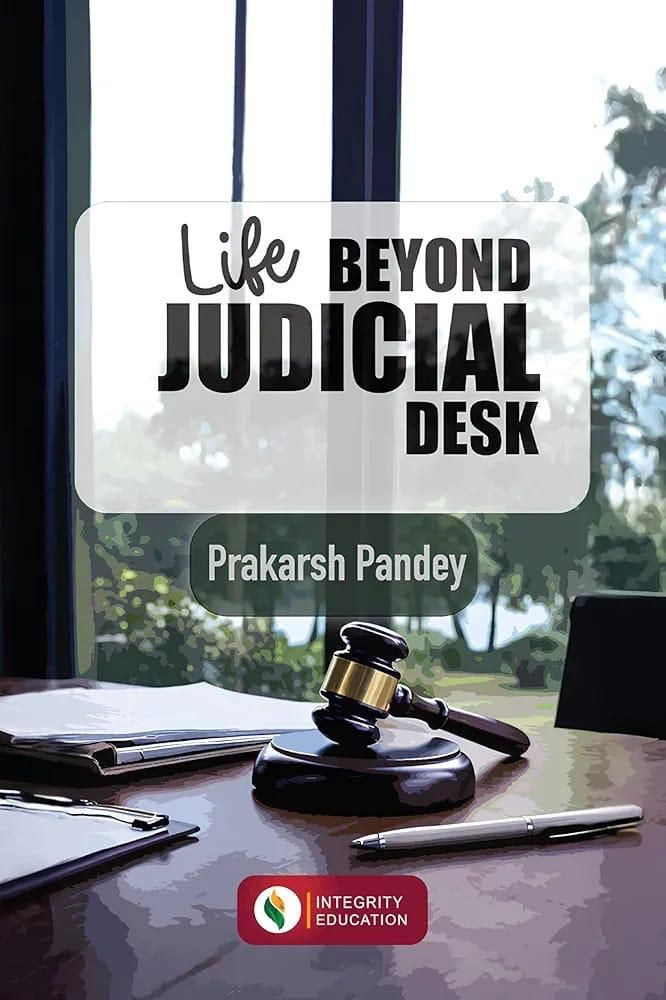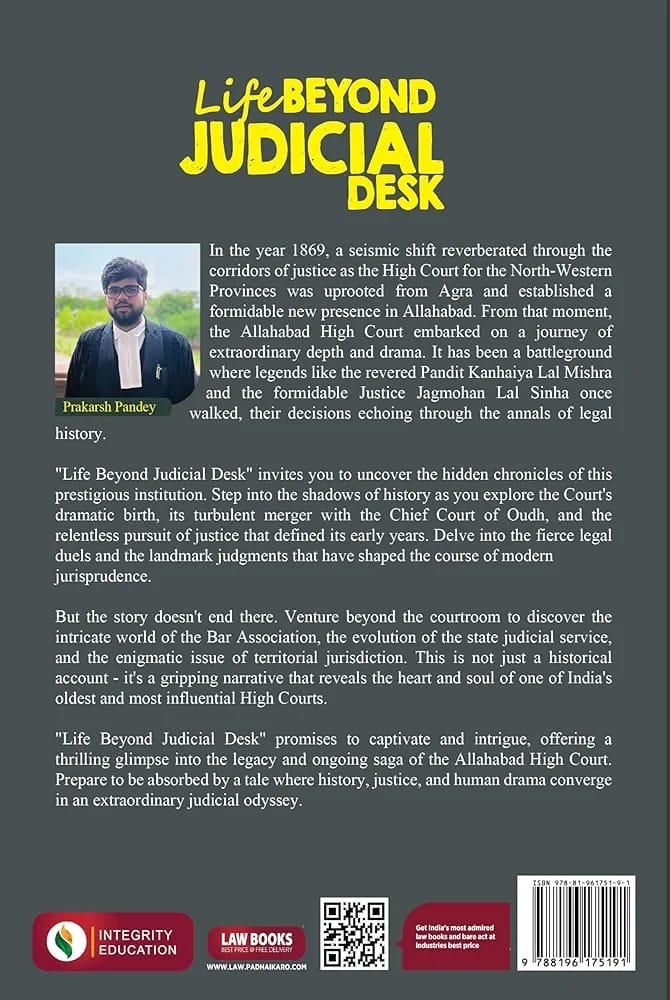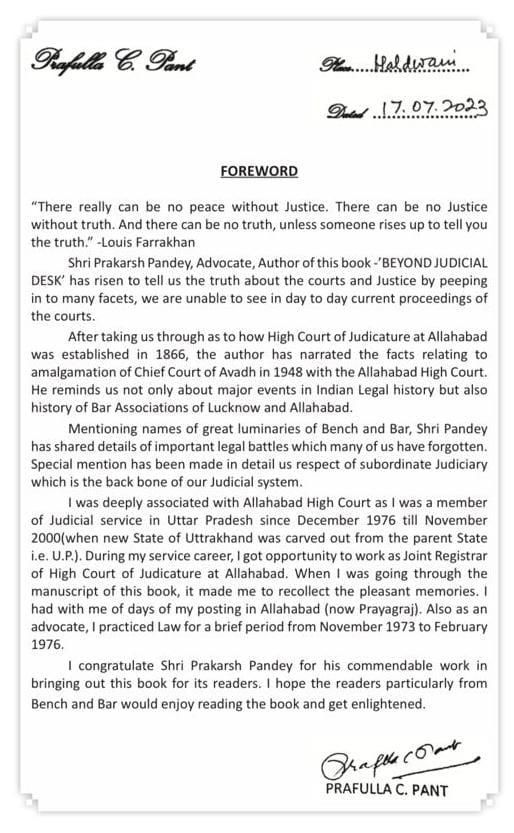
Life Beyond Judicial Desk: A Tapestry of Justice, Courage, and Humanity
In the heart of India’s sprawling democracy, where the judiciary stands as a revered pillar, Prakarsh Pandey’s Life Beyond Judicial Desk emerges as a heartfelt chronicle of the Allahabad High Court’s legacy. This book is not merely a recounting of legal milestones but a vibrant mosaic of human stories, woven with threads of integrity, resilience, and inspiration. Through its pages, Pandey invites readers to peer beyond the courtroom’s stern facade, revealing the lives, struggles, and triumphs of those who uphold justice.


A Glimpse into History
The book opens with a vivid exploration of the Allahabad High Court’s origins, established in 1866 as the High Court for North Western Provinces. Pandey meticulously traces its evolution, from the dissolution of the Sudder Diwany Adalat to the amalgamation with the Chief Court of Oudh in 1948. He writes:
The Allahabad High Court boasts a rich legacy of unwavering judicial autonomy. A notable instance from this legacy occurred in 1937, under the leadership of Justice Sir John Gibb Thom. During this period, the chief secretary to the United Provinces Government dispatched a notification to several sessions’ judges across the state, expressing concerns about the frequent granting of bail to individuals accused of criminal offenses. However, this intervention did not sit favorably with the Chief Justice. In a resolute response, he demanded that the chief secretary retract the letter, warning of potential criminal contempt charges should he fail to comply.
This anecdote, drawn from page 10, captures the court’s fierce independence, a theme that reverberates throughout the book. The inclusion of such historical vignettes, paired with Pandey’s accessible prose, makes the court’s storied past come alive, inviting readers to appreciate its role in shaping India’s legal landscape.
The Heartbeat of the Judiciary: Human Stories
What sets Life Beyond Judicial Desk apart is its humanistic lens, particularly in the chapter “Stories that will Inspire Law Students.” Here, Pandey profiles legal luminaries whose journeys transcend the courtroom, offering lessons in perseverance and compassion. Take, for instance, the story of Dr. Lalta Prasad Misra, whose early life in the village of Gola Ganj is recounted with warmth:
From a tender age, Dr. Mishra displayed an insatiable thirst for knowledge. His fondness for reading and writing was evident to all. At the age of four, while his peers attended the school on the veranda, Dr. Mishra would eagerly join them. His enthusiasm was so intense that he would not let his presence go unnoticed. Sometimes, during attendance calls, when the teacher inadvertently omitted his name, young Dr. Mishra would cry, bursting into tears.
This excerpt from page 202 paints a tender portrait of a young boy whose passion for learning propelled him to become a towering figure in the legal fraternity. Dr. Misra’s story, marked by his daily treks across the Bhakosa river to attend school, resonates with anyone who has faced obstacles in pursuit of a dream. Pandey’s storytelling transforms Dr. Misra from a legal icon into a relatable figure, embodying the universal quest for knowledge and justice.
Similarly, the narrative of Justice Imtiaz Murtaza, found on page 207, is infused with nostalgia and resilience:
In an era when our ancestors still bore a striking resemblance to apes, surviving on raw and uncooked sustenance, Justice Murtaza’s journey was characterised by a shift to properly baked and cooked meals. The 21st century had ushered in a technological revolution, where booking a ticket and traversing vast distances had become as easy as clicking a button.
This passage juxtaposes societal evolution with Murtaza’s personal growth, from a cricket-loving child to a distinguished judge. His reflections on a nomadic childhood, shaped by his father’s transferable job, and his eventual rise in the legal world, highlight the interplay of personal and professional growth. Pandey’s empathetic tone ensures that these stories are not just biographies but beacons of hope for aspiring lawyers.
The Bar Associations: Pillars of Community
Pandey dedicates a chapter to the Oudh Bar Association and the High Court Bar Association of Allahabad, emphasising their role as the judiciary’s backbone. He quotes the late Pandit Kanhaiya Lal Misra:
The judicial wheel is rounded with equality, oiled with honour and functions smoothly with honesty—principally when both members of the Bench and Bar shoulder their responsibilities seriously.
This quote, from page 13, underscores the symbiotic relationship between the bench and bar. The Oudh Bar Association, established in 1901, is portrayed as a cradle of legal titans, including figures like Satish Chandra Misra and Brijesh Pathak. Pandey’s detailed account of its history, complete with names like H.S. Jackson and Pandit Jagat Narayan, adds depth and intrigue. The High Court Bar Association’s evolution, marked by the merger of the Barristers’ and Vakils’ Associations in 1957, is equally compelling, highlighting the court’s commitment to inclusivity and professionalism.
Legal Landmarks and Controversies
The book also delves into pivotal legal cases and jurisdictional debates, such as the Keshav Singh case, where the Uttar Pradesh legislative assembly’s attempt to arrest sitting judges sparked a constitutional crisis. Pandey recounts:
In a bid to unravel this cryptic conundrum, Chief Justice Desai of that era convened an unprecedented bench of 28 judges, a record-setting number in the history of Independent India.
This dramatic moment, detailed on page 10, showcases the judiciary’s resilience in safeguarding its independence. The chapter on jurisdiction, exploring the Allahabad-Lucknow bench rivalry, is equally gripping. Pandey’s analysis of the 1948 Amalgamation Order, particularly Article 14, clarifies the permanent seat of the High Court at Allahabad, offering readers a nuanced understanding of legal intricacies.
A Call to Inspiration
Life Beyond Judicial Desk is more than a historical or legal treatise; it is a celebration of the human spirit within the judiciary. Pandey’s acknowledgement of contributors, from Justice SS Sodhi to his brother Shivam, who inspired the book’s title, reflects a collaborative effort rooted in passion. The foreword by Justice Prafulla C. Pant, who reminisces about his time at the Allahabad High Court, adds a personal touch:
When I was going through the manuscript of this book, it made me to recollect the pleasant memories. I had with me of days of my posting in Allahabad (now Prayagraj).

This reflection, from page 3, sets the tone for a book that balances scholarly rigor with emotional resonance. Pandey’s call to young law students is clear: the judiciary is not just about laws but about lives, courage, and the pursuit of truth.
Final Thoughts
Life Beyond Judicial Desk is a captivating read for anyone interested in India’s legal history or the human stories behind the gavel. Prakarsh Pandey’s ability to blend historical facts, legal analysis, and personal narratives creates a work that is both informative and inspiring. The book’s strength lies in its humanistic approach, reminding us that justice is not an abstract ideal but a lived experience, shaped by individuals like Pt. Kanhaiyalal Mishra, Justice Jagmohanlal Sinha, and Dr. Lalta Prasad Misra. For law students, legal professionals, or anyone seeking stories of resilience, this book is a treasure trove of wisdom and inspiration, a testament to the enduring spirit of the Allahabad High Court.
Get your copy at:
https://www.amazon.in/LIFE-BEYOND-JUDICIAL-Prakarsh-Pandey/dp/8196175191
Appreciate the creator